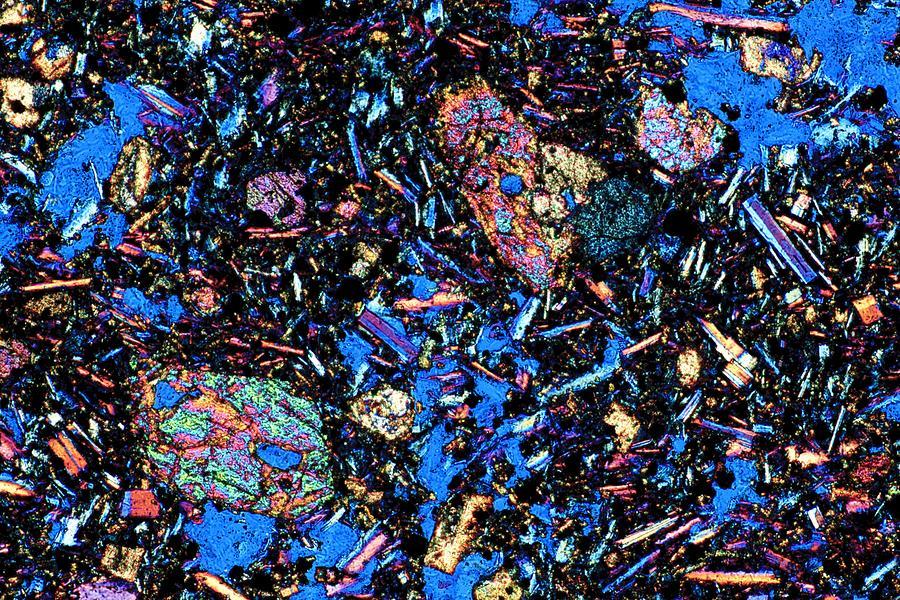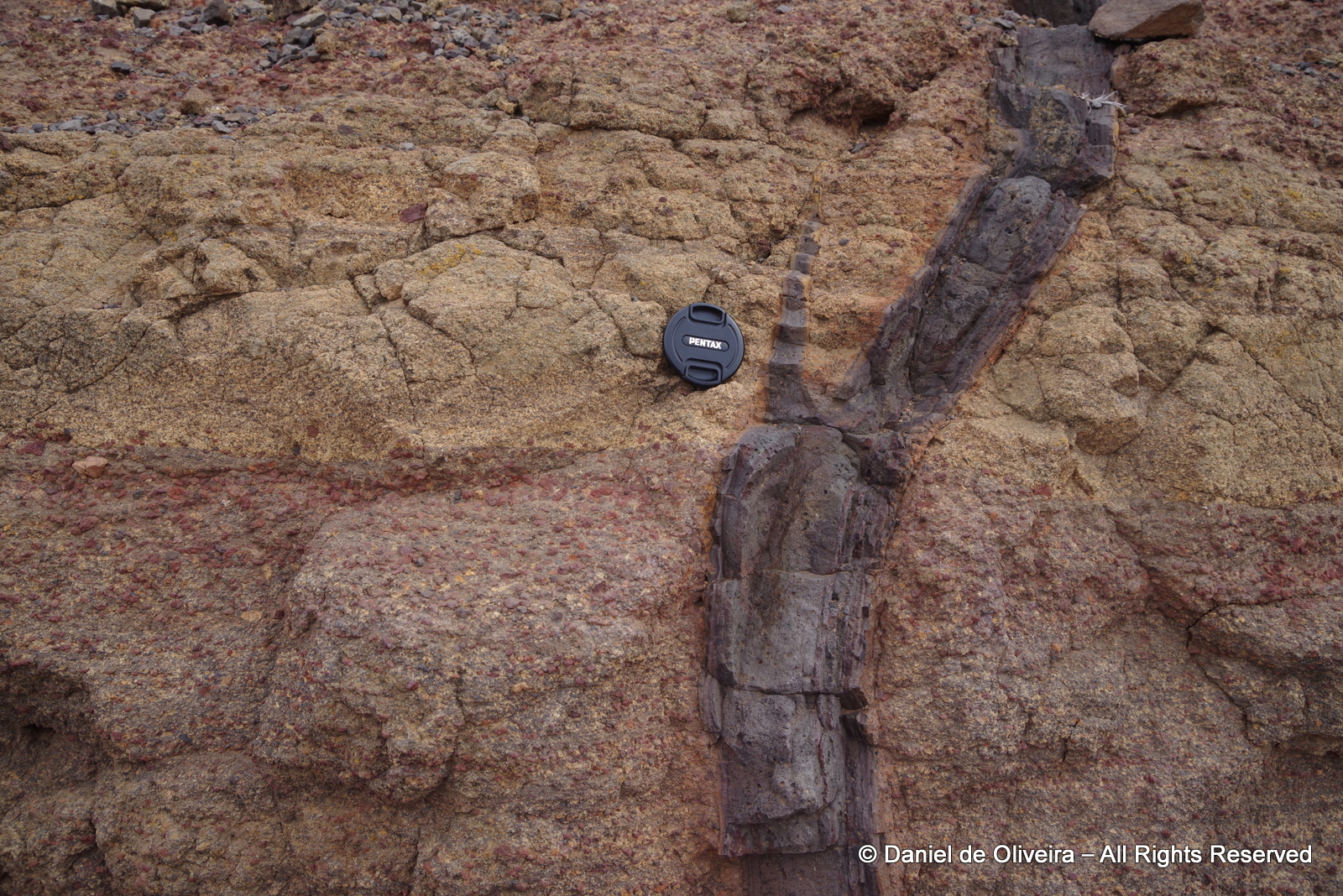
Basalt is one of the most common rock types in the world. Basalt is the rock most typical of large igneous provinces. It is the most common volcanic rock type on Earth, being a key component of oceanic crust as well as the principal volcanic rock in many mid-oceanic islands, including Iceland, the Faroe Islands, Réunion and the islands of Hawaii. Basalt is a common extrusive igneous (volcanic) rock formed from the rapid cooling of basaltic lava exposed at or very near the surface. It is an aphanitic (fine-grained) igneous rock with generally 45-55% silica (SiO2) and less than 10% feldspathoid by volume, and where at least 65% of the rock is feldspar in the form of plagioclase. Basalt commonly features a very fine-grained or glassy matrix interspersed with visible mineral grains. The average density is 3.0 g/cm3.

Columnar basalt
During the cooling of a thick lava flow, contractional joints or fractures form. If a flow cools relatively rapidly, significant contraction forces build up. While a flow can shrink in the vertical dimension without fracturing, it can't easily accommodate shrinking in the horizontal direction unless cracks form; the extensive fracture network that develops results in the formation of columns. The topology of the lateral shapes of these columns can broadly be classed as a random cellular network. These structures are predominantly hexagonal in cross-section, but polygons with three to twelve or more sides can be observed. The size of the columns depends loosely on the rate of cooling; very rapid cooling may result in very small (<1 cm diameter) columns, while slow cooling is more likely to produce large columns.
The earthcache will take you face to face with a basalt dyke that shows some spectacular columnar jointing. Here you are asked to validate the find for this EC by answering these simple questions:
- 1- Based on the diameter of the columns, has this lava cooled slowly or fast? Justify.
- 2- What is the radius of the columns (measure centre to rim)?
- 3 -What colour is the basalt?
- 4 - Can you detect individual minerals in the rock?
- 5 - Observe up close. What is the one common feature of this basalt in terms of morphology and appearance?
If you think you know all the answers, please log your found but send me, through my profile, the answers (*). If they are correct, you will not hear from me again but know that I truly appreciate you taking the time to visit this corner of the planet and I hope that you have learnt a little bit more about the geological processes that take place on the surface of the earth. If they’re wrong I will send you an explanatory note showing you where you went wrong. If you don’t send the answers, your log will be deleted without any explanation.

(*) Please note that when you e-mail me, please supply the reference (GC7DZB8) and name (Organ Pipes - DP/EC one-o-three) of the cache and please click on the “I want to send my e-mail address along with this message” so that when I reply to you the messages don’t go into e-mail heaven (or hell).

O basalto é uma rocha ígnea eruptiva de composição máfica, por isso rica em silicatos de magnésio e ferro e com baixo conteúdo em sílica, que constitui uma das rochas mais abundantes na crusta terrestre. É uma rocha de granulação fina, coloração escura, matriz afanítica, frequentemente com textura porfírica, com fenocristais de olivina, augite e plagioclase, e uma matriz cristalina fina. Como minerais acessórios encontram-se, principalmente, óxidos de ferro e titânio. Ocasionalmente encontram-se basaltos com matriz vítrea, denominados sideromelanos, com raros cristais ou mesmo sem eles. O basalto, pela sua dureza e resistência à meteorização, é explorada para a produção de alvenarias e de agregados de construção civil e como rocha ornamental para revestimentos e calçadas.
 Basalto é, por definição assente no diagrama QAPF (diagrama de Streckeisen), uma rocha ígnea afanítica (de grão fino) com geralmente 45-55% de sílica (SiO2) e menos de 10% de minerais feldspatoides por volume, e onde pelo menos 65% do volume da rocha é constituído por feldspato na forma de plagioclase. Os basaltos são o tipo mais comum de rocha vulcânica na Terra, sendo um componente chave da crusta oceânica e a principal rocha constituinte da generalidade das ilhas oceânicas, incluindo a Islândia, os Açores, a Madeira, as Canárias, Cabo Verde, Reunião e as ilhas do Hawaii. Os basaltos apresentam em geral uma matriz de grãos muito finos, ou mesmo de vidro vulcânico, intercalada com grão minerais visíveis a olho nu, os fenocristais. A densidade média é de 2,8-3,0 g/cm3.
Basalto é, por definição assente no diagrama QAPF (diagrama de Streckeisen), uma rocha ígnea afanítica (de grão fino) com geralmente 45-55% de sílica (SiO2) e menos de 10% de minerais feldspatoides por volume, e onde pelo menos 65% do volume da rocha é constituído por feldspato na forma de plagioclase. Os basaltos são o tipo mais comum de rocha vulcânica na Terra, sendo um componente chave da crusta oceânica e a principal rocha constituinte da generalidade das ilhas oceânicas, incluindo a Islândia, os Açores, a Madeira, as Canárias, Cabo Verde, Reunião e as ilhas do Hawaii. Os basaltos apresentam em geral uma matriz de grãos muito finos, ou mesmo de vidro vulcânico, intercalada com grão minerais visíveis a olho nu, os fenocristais. A densidade média é de 2,8-3,0 g/cm3.
Disjunção prismática, ou disjunção colunar, é a designação dada em geologia e geomorfologia às formações constituídas por grandes prismas de rocha separadas por diaclases paralelas que se formam em resultado das tensões que se geram durante o processo de arrefecimento de massas de magma ou lava. Dada a sua origem, as formações colunares resultantes ocorrem exclusivamente em rochas ígneas do tipo vulcânico e subvulcânico, sendo mais frequente nos basaltos, especialmente quando em escoadas lávicas espessas, em lagos de lava ou no material que preenche as chaminés vulcânicas. Quando o material arrefece em camadas de espessura uniforme, as dicalases formam-se perpendicularmente à superfície de arrefecimento e resultam na formação de estruturas colunares aprumadas, de lados perfeitamente paralelos e secção perfeitamente hexagonal, razão pela qual as colunas de 6 lados são as de ocorrência mais comum. Quando a espessura varia lateralmente, formam-se colunas que podem variar em direcção e em espessura e apresentar diferente número de lados, mais frequentemente de 5 a 7.
Esta earthcache irá levar-te a um confronto cara a cara com um dique de basalto que mostra disjunção prismática espetaculares. Aqui, é solicitado a validar o “Found it” para esta EC respondendo estas simples perguntas:
1- Com base no diâmetro das colunas, esta lava foi arrefecida lentamente ou rapidamente? Justificar.
2- Qual é o raio das colunas (medir do centro para a borda)?
3- Qual a cor do basalto?
4- Consegues detectar minerais individuais na rocha?
5- Observa de perto. Qual é a característica comum deste basalto em termos de morfologia e aparência?
Se achas que sabes todas as respostas, por favor faz o teu log de “found”, mas ao mesmo tempo envia-me as respostas a estas perguntas (* - ver em cima).
Se estiverem correctas, não respondo mas fica sabendo que eu estimo a tua visita a este cantinho do planeta e espero que esta cache sirva para desvendar mais um mistério dos processos geológicos da nossa bola azul. Se estiveram erradas, vais a exame novamente e levas com TPC’s extras. Porém se não enviares as respostas, simplesmente apago o log.

 The most exciting way to learn about the Earth and its processes is to get into the outdoors and experience it first-hand. Visiting an Earthcache is a great outdoor activity the whole family can enjoy. An Earthcache is a special place that people can visit to learn about a unique geoscience feature or aspect of our Earth. Earthcaches include a set of educational notes and the details about where to find the location (latitude and longitude). Visitors to Earthcaches can see how our planet has been shaped by geological processes, how we manage the resources and how scientists gather evidence to learn about the Earth. To find out more click HERE.
The most exciting way to learn about the Earth and its processes is to get into the outdoors and experience it first-hand. Visiting an Earthcache is a great outdoor activity the whole family can enjoy. An Earthcache is a special place that people can visit to learn about a unique geoscience feature or aspect of our Earth. Earthcaches include a set of educational notes and the details about where to find the location (latitude and longitude). Visitors to Earthcaches can see how our planet has been shaped by geological processes, how we manage the resources and how scientists gather evidence to learn about the Earth. To find out more click HERE.